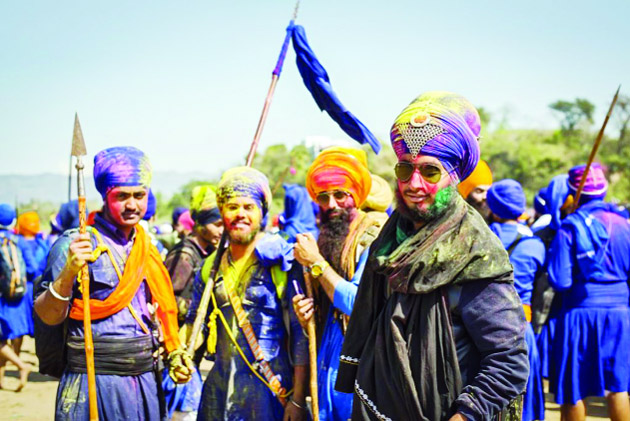Inderjeet S.Bhatia ‘Prince
HOLLA MOHALLA, also referred to as HOLLA, is a 3 day long Sikh festival which normally falls in the month of March. It takes place on the 2nd day of the lunar month of Chet,usually one day after the Hindu festival of Holi but sometimes coincides with it.HOLLA, was established by the 10th Sikh Guru, Shree Guru Gobind Singh Sahib Ji in the spring of 1701 AD at Anandpur Sahib.
Guru Gobind Singh Ji summoned his followers to Anandpur Sahib on the day of popular Hindu festival Holi.It is believed that the festival of Holi and the story of Holika Dehan was very popular amongst the followers of Guru ji.Guru ji thought of introducing the martial element in the celebration of Holi.Then there was a popular story of child Bhagat Parhlad who would not accept his father, the king Harnaakashp as God. In order to please her brother, Holika ,the sister of Harnaakashp sat on a pyre with child Bhagat Parhlad in her lap hoping that the magical powers of his brother will save her and the child Bhagat Parhlad will perish once the pyre was lit.But when the pyre was lit , the child Prahlad survived and it was Holika who perished in it. This story confirms the belief that it is the truth that triumphs over the evil .This was the principle upon which the Sikh festival of HOLLA MOHALLA was established. Guru ji introduced a rally there one day after the festival of Holi where his followers could practice maneouvers and combat training. According to historians, the 1st HOLLA MOHALLA procession was organised by Guru Gobind Singh Sahib Ji on 22nd February, 1701.Guru ji made Holla,an occasion for his followers to demonstrate their martial arts in staged battles. This was probably done to forestall a glimmer battle against the Mughals and some hilly Rajas who were acting against Guru ji at the behest of Imperial forces. It was also to channelise people’s energy to some useful activities. HOLLA, thus became an annual event to be held in an open ground near Holgarh,a fort across the river Charan Ganga ,flowing to the north west end of Anandpur Sahib.
HOLLA is the masculine form of the feminine word Holi. The word MOHALLA is derived from the Arabic root hal ( alighting or decending ), is a Punjabi word that implies an organised procession in the form of an army column.
But unlike Holi, where people playfully sprinkle color, dry or mixed in water, HOLLA is an occasion for the Sikhs to demonstrate their martial skills in simulated battles.HOLLA MOHALLA has since been accorded the status of a national festival by the Govt of India : “This annual festival held in Anandpur Sahib in Punjab and now replicated at other Gurdwaras worldwide was started by the 10th Sikh Guru, GURU GOBIND SINGH SAHIB JI as a gathering of the Sikhs for military exercises and mock battles on a day following the Hindu festival of Holi. It reminds people of valour and defense preparedness, the concepts dear to the 10th Sikh Guru who was at that time fighting against the mighty Mughal empire and also some hilly Kings who were acting against Guru ji at the behest of Imperial forces.”
The festivities start with early morning prayers at the Gurudwara Sahib. Devotional music and the recital of Shabad Gurbaani follows. Stories are told about the valour of Sikh Gurus. After prayers, a number of festivities take place simultaneously . From the main Gurudwara Sahib, celebrations move to the Charan Ganga stadium. At the stadium, participants put up a display of skills. The remarkable feats of courage, skill and discipline attract a large crowd who watch the festivities. Horsemanship plays a huge role in the festivities. The display of horse riding goes beyond the basic with some taking on daredevils acts, riding not one or two but three and sometimes even four horses at the same time.Friendly competitions of sword fighting are held with Nihang fighting from the different groups displaying their skills in the art. Another area of skill display is on the Motorbike.Participants display rigorously practiced feats like riding a bike blind folded, standing up straight on a moving bike and showing off their skills in marksmanship and more. Most of the participants dress in their ethnic attire during the festival. They wear the traditional blue robes and embellished dastars, which are tall turbans, mostly of blue color (sometimes in yellow too.)
It may be recalled that in Sikhism, blue color signifies courage, bravery and patriotism whereas yellow stands for honor, sacrifice and revolt.
On the 3rd and last day of HOLLA MOHALLA, a long procession led by 5 Pyaras, starts from Takht Keshgarh Sahib, one of the 5 Sikh religious seats and passes through various important Gurudwaras like Qila Anandpur Sahib ,Quila Lohgarh Sahib, Gurudwara Mata Jito Ji and terminates at its starting point i.e Gurudwara Shree Keshgarh Sahib. The most important part of the procession is the participation of NIHANGS SINGHS in their traditional attires and demonstrating their skills in the use of arms, horsemanship, tent pigging and other war like sports. NIHANG SINGHS are endearingly designated as Guru ji’s beloved. They still carry the military ambience and heroic style that was cultivated during the lifetime of 10th Sikh Guru, GURU GOBIND SINGH JI. As stated earlier, NIHANG SINGHS constitute a distinctive order among the Sikhs and are readily recognized by their dark blue dress (BANA), and their ample “DUMALLAS”.They present the most spectacular part of the final day procession of HOLLA MOHALLA at Anandpur Sahib.
In the end, it can be said that NIHANG SINGHS deserve all the praise who have tried to preserve the traditional form and content of the Sikh festival of HOLLA MOHALLA, as established during its inception by the 10th Sikh Guru, GURU GOBIND SINGH JI and are strictly following the values and guidelines with success for the last more than three centuries.


